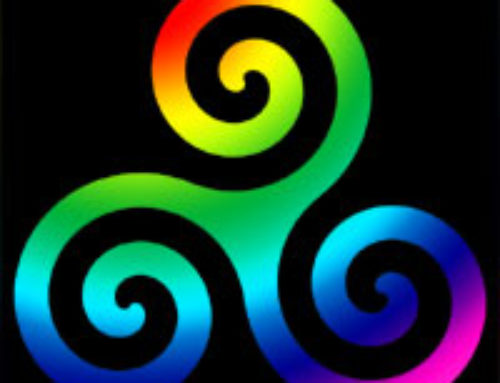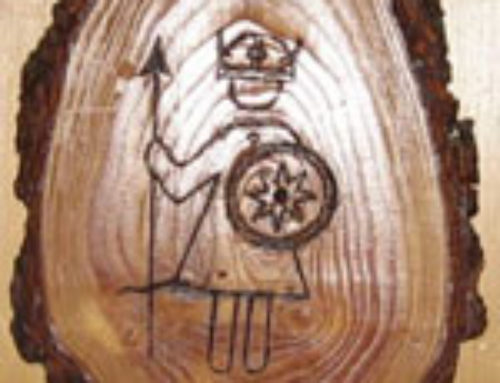Quick and Dirty Guide to Anglo-Saxon Pronunciation and Icelandic Pronunciation for Norse Pagan Rituals
An Idiot’s Guide to Pronouncing the Anglo Saxon Rune Poems and Charms,
and Old Norse from the Poetic Edda and Prose Edda
This is an “I need it NOW!” pronunciation guide for reciting phrases and quotes in Anglo-Saxon and Icelandic. It’s mainly intended for Pagans (Norse Pagans, Heathens, Asatru, Vanatru, or Rokkatru, etc.) who want to pick up a bit of old language and read it out loud for a ritual, or pronounce a goddess’ name properly.
Learning these languages can take a lifetime, and most of us just aren’t inclined to make THAT much of a sacrifice to our gods. But throwing in a few Icelandic phrases can really liven up a rite ! Okay, okay, I’m a geek, I admit it… But say you’re honoring a goddess like Vör, about whom almost nothing is known, with a grand total of three lines of description in the Prose Edda. Well, first, it’d be nice to pronounce her name properly. And then, why not read that paragraph aloud, IN ICELANDIC? With this quick guide and a little practice, you can do that.
If you need to print and run with it right away, get the pronunciation summary in MS-Word .doc format. Just right click on the link to save it. Apologies to users of Linux, Mac, and other superior beings who may be offended by this format…
Proper spelling of Norse god names in IcelandicFor quick reference, as listed in the Skáldskaparmál 1 (Prose Edda): Hann gerði ferð sína til Ásgarðs (…) Þá gengu æsir at gildi sínu, ok settust í hásæti tólf Æsir, þeir er dómendr skyldu vera ok svá váru nefndir: Óðinn, Þór (Ásaþor, Ökuþor) , Njörður, Freyr, Týr, Heimdallur, Bragi, Viðar, Váli, Ullur, Hænir, Forseti, Loki. Slíkt sama Ásynjur: Frigg, Freyja, Gefjun, Iðunn, Gerður, Sigyn, Fulla, Nanna.
And from Gylfaginning 35: “Hverjar eru ásynjurmar?” Frigg er æðst, önnur er Sága, þriðja er Eir, fjórða er Gefjun, fimmta er Fulla, Freyja er tignust með Frigg. Sjöunda Sjöfn, áttunda Lofn, níunda Vár, tiunda Vör, ellefta Syn, tólfta Hlín, þrettánda Snotra, fjortánda Gná. Sól og Bil eru taldar með ásynjum.
|
What is Icelandic, and why do I care ?
Modern Icelandic is the language spoken in Iceland right now. While only a few hundred thousand people speak it, it’s interesting because it’s almost the same langage as what was spoken by the Vikings a thousand years ago (Old Norse, or more specifically, Old West Norse). It’s changed very very little. Icelanders can read thousand year old sagas the same way we read Shakespeare´s English. Meaning, it sounds formal, uses some archaic words, but you generally understand it without much difficulty. For example “Thou art a ruffian!” is clearly understood by modern English speakers. Anglo-Saxon (Old English), on the other hand, is nearly incomprehensible: “hwæt we gar-dena in geardagum” means “Lo, praise of the prowess of people-kings “. It´s the first line of Beowulf.
The best part of Icelandic is that since it is a living language, you can find language tutor books and audio CDs to learn it! Anglo-Saxon is a dead language, as is Old Norse, so even the best scholars are just making very educated guesses about the original pronunciation. I believe Modern Icelandic, with some archaic forms thrown in, is the best choice as a liturgical language for Pagans practicing in the Northern Tradition, be they Heathens, Asatru, Vanatru, or Rokkatru. It’s very challenging, but not insurmountable.
What Alphabet Does Icelandic Use?
a á b d ð e é f g h i í j k l m n o ó p r s t u ú v x y ý þ æ ö
- You’ll notice that ð, þ and æ aren’t in English. C, Q and W are only used in foreign words, and Z is no longer in use.
- The letters a, á, e, é, i, í, o, ó, u, ú, y, ý, æ and ö are considered vowels, and the rest are consonants.
- The order you see above is what is used in dictionaries, accented letters are considered to be distinct letters.
How Do You Pronounce Icelandic ?
Vowels and Diphthongs
a : like ‘a’ in father, — French ‘a’ in “gars”. Ex. sandur (sand)
á : like ‘ow’ in “down”. Ex. ást (love)
e : like ‘e’ in “bed”, — French ‘ê’ in “prêt”. Ex. senda (send)
é : like ‘ye’ in “yes”, — French ‘yai’ in “balayait”. Ex. ég (I)
i : like ‘i’ in “bid” or “hid”, — French ‘i’ in “fille”. Ex. listi (list)
y : like ‘i’ in “bid” or “hid”, — French ‘i’ in “fille”. Ex. synda (swim)
í : like ‘ee’ in “sheet”. — French ‘i’ in “lit”. Ex. sími (phone)
ý : like ‘ee’ in “sheet”. — French ‘i’ in “lit”. Ex. sýna (show)
æ : like ‘i’ in “hide”. — French ‘ai’ in “canaille”.Ex. læsa (lock)
o : like ‘aw’ in “law”. Ex. loft (air)
ó : like ‘oa’ in “boat, — French ‘au’ in “autre”. Ex. bóndi (farmer)
u : same as French u in tu, or German für. Make it by pursing your lips like you do to say ‘tool’, but instead saying ‘feet’. Ex. hundur (dog)
ú : like ‘o’ in “who”, — French ‘ou’ in “tout”. Ex. Rússland (Russia)
ö : like ‘e’ in “nerd”, — French ‘eu’ in “feu”. Ex. hönd (hand)
ei : like ‘a’ in “came”, — French é in “fée”. Ex. neisti (spark)
ey : like ‘a’ in “came”, — French é in “fée”. Ex. keyra (drive)
au : as French “oeil”. Try to say “Freud” with pursed lips, it’s like the ‘eu’ part of it. Ex. haust (autumn)
Consonants
– þ : like ‘th’ in “thorn”
– ð : like ‘th’ in “the”
– j : is like ‘y’ in “yes”, — French ‘y’ in “balayait”. Ex. já (yes)
– r : is rolled similar to “brrr!” when it is cold. It is like the Spanish ‘r’
– ll : is pronounced ‘dl’ or ‘tl’
– tt : is pronounced ‘ht’. Ex. gott (good) is pronounced “goht”
– kk : is pronounced ‘hk’.
– pp : is pronounced ‘hp’.
Double consonants are normally held longer IF they come directly after the stressed vowel.
What is Anglo Saxon?
Also known as Old English, Anglo-Saxon was a Germanic language spoken in the southern part of what is now England more than a thousand years ago. It emerged when three groups of people from Northern Germany (the Angles, Saxons and Jutes) came to England in the 5th century and merged into one. It’s closely related to Old High German, Frisian and Scandinavian, and still shares similarities with modern German and Dutch. Native Britons spoke an ancient form of Welsh, a Celtic language.
What Alphabet Did They Use?
a b c d e f g h i l m n o p r s t u w x y þ ð æ
- You’ll notice the last three letters aren’t in English, and three letters are missing: J, Q and Z.
- When using English fonts, “th” is used for þ, “dh” is used for ð, and “ae” is used for æ.
- There was no upper case letters, though modern writers sometimes add them in.
- Anglo-Saxon had short and long forms of vowels. Long vowels had a bar over them, but modern fonts use a rising accent instead : á, é, í, ó, ú
- Ancient manuscripts used the Irish alphabet, so a number of letters are hard for modern readers to recognize.
How Do You Pronounce Anglo-Saxon ?
There is no definitive way to pronounce it, Scholars debate it, and it would have varied by region, as it does today. In any case, you can expect to “speak it with an accent” with this rough guide (which assumes East Coast American English pronounciation), and it’s probably good enough for most purposes.
Vowels and Diphthongs
a : as ‘a’ in father, — French ‘a’ in “gars”
e : as ‘a’ in fate, — French ‘é’ in “dé”
i : as ‘ee’ in feet, — French ‘i’ in “lit”
æ : as ‘a’ in cat, — French ‘a’ in “massage”
o : as ‘oa’ in boat, — French “eau”
u : as ‘oo’ in tool, — French ‘ou’ in “fou”
y : same as French ‘u’ in “tu”, or German für (y is always a vowel in AS, never a consonant). Make it by pursing your lips like you do to say “tool”, but instead saying “feet”.
ie : ih – eh (it’s one continuous sound, not two)
eo : eh – o (short o like in pot, it’s one continuous sound, not two)
ea : eh – ah (it’s one continuous sound, not two)
Accented forms sound much the same, but are held longer.
Consonants
– þ : like ‘th’ in “thorn”
– ð : like ‘th’ in “the”
– c : like ‘K’, or sometimes ‘ch’ as in “chin” (sometimes written with a dot on the ‘c’ to differentiate it)
– g : as in “good” in the beginning of a word or syllable, otherwise generally as ‘y’ as in “yes”(sometimes written with a dot on the ‘g’ to differentiate it)
– f : as in “father”. Ex. ful (full), cræft (craft) and wulf (wolf’). Or ‘v’ as in “voice” when between vowels or voiced sounds. Ex.’heofon’ (heaven), hæfde (had), wulfas (wolves)
– s : as in “silly”. Ex. settan (set), frost (frost), wulfas (wolves). Or ‘z’ as in “zebra” when between vowels or voiced sounds. Ex. ‘s’ of ċēosan (choose)
– cg : is like the ‘dge’ of Modern English “sedge”. Ex. hrycg (ridge, back), brycg (bridge), ecg (edge).
– sc : is usually like ‘sh’ in “ship”. Ex. scip (ship), æsc (ash, the tree), wýscan (wish). But can also sound as sk, if it is before the vowels a, o, u, or behind them at the end of word. Ex. as in ascian (ask). Occasionally, it sounds like ks (or x).
- There are no silent consonants. “H” is never silent, it is pronounced like in “he”, or sometimes like the German ch in Nacht or ich.
- Double consonants are pronounced twice or held longer. ‘wile’ means “he will”, but ‘wille’ means “I will”.
- The stress is always on the first syllable (as it usually is in English), except for words beginning with the prefix ġe- where the stress is on the second syllable, and the stress is on the second syllable for verbs beginning with a prefix.
References
- University Website on Anglo-Saxon pronunciation. I don’t have books on Anglo Saxon.
- BBC article on the Anglo-Saxon language, which I used for the historical recap.
- Teach Yourself Icelandic, by Hildur Jónsdóttir, for Icelandic Pronunciation, a very good book / CD combo, which I refer to a lot, mainly for the pronounciation guide. Sadly, the pronounciation quirks of the language are scattered throughout the book, which makes them hard to find.
- Learning Icelandic, by Auður Einarsdóttir et al., BEST book for learning Icelandic! Make sure to get it with the CD. Can be difficult to get outside of Iceland, this is a link to the Icelandic store. The one you want has a blue cover, the green one is the grammar exercise book. It doesn’t have a pronunciation guide, but it does have an awesome lexicon and grammar section, in addition to the funny conversations that form the bulk of this tutorial.






Leave A Comment
You must be logged in to post a comment.